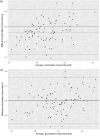Estimating sodium and potassium intakes in a Portuguese adult population: can first-morning void urine replace 24-hour urine samples?
- PMID: 40166610
- PMCID: PMC11955307
- DOI: 10.1017/jns.2025.16
Estimating sodium and potassium intakes in a Portuguese adult population: can first-morning void urine replace 24-hour urine samples?
Abstract
This study aimed to assess the extent to which first-morning void (FMV) urine samples can estimate sodium and potassium excretion compared with 24-hour (24-h) urine samples at the population level. We conducted a cross-sectional study collecting urine samples (FMV and 24-h) and two non-consecutive 24-h dietary recalls in a sub-sample from the Portuguese IAN-AF sampling frame. Six predictive equations were used to estimate 24-h sodium and potassium excretion from FMV urine samples. Pearson correlation coefficients were calculated to compare the association between FMV and 24-h urine collections. Cross-classifications into tertiles were computed to calculate the agreement between measured and estimated excretion with and without calibration. Pearson correlation coefficients were calculated to compare the excretion estimation from FMV and reported intake from 24-h dietary recalls. Bland-Altman plots assessed the agreement between two-day dietary recall and the best-performing calibrated equation. Data from eighty-six subjects aged 18-84 were analysed. Estimated sodium and potassium concentrations from the predictive equations moderate or strongly correlated with the measured 24-h urine samples. The Toft equation was the most predictive and reliable, displaying a moderate correlation (r=0.655) with no risk of over or underestimation of sodium excretion (p=0.096). Tanaka and Kawasaki equations showed a similar moderate correlation (r=0.54 and r=0.58, respectively) but tended to underestimate the 24-h urine excretion of potassium (p<0.001). Calibrated predictive equations using FMV urine samples provide a moderately accurate alternative and resource-efficient option for large-scale nutritional epidemiology studies when 24-h urine collection is impractical.
Keywords: 24-h urine excretion; 24-h, 24-hour; BMI, body mass index; CI, confidence interval; CVD, cardiovascular diseases; D, day; Dietary intake; FMV, first-morning void; IAN-AF, National Food, Nutrition and Physical Activity Survey; PABA, para-aminobenzoic acid; Potassium; SD, standard deviationl; Sodium; Spot urine samples; USA, United States of America; Urine specimen collection; WHO, World Health Organization.
© The Author(s) 2025.
Conflict of interest statement
The authors declare none.
Figures

Similar articles
-
Estimating sodium intake from spot urine samples at population level: a validation and application study in French adults.Br J Nutr. 2019 Jul 28;122(2):186-194. doi: 10.1017/S0007114519000886. Epub 2019 Jul 16. Br J Nutr. 2019. PMID: 31006386
-
Validation and Assessment of Three Methods to Estimate 24-h Urinary Sodium Excretion from Spot Urine Samples in High-Risk Elder Patients of Stroke from the Rural Areas of Shaanxi Province.Int J Environ Res Public Health. 2017 Oct 11;14(10):1211. doi: 10.3390/ijerph14101211. Int J Environ Res Public Health. 2017. PMID: 29019912 Free PMC article. Clinical Trial.
-
Urine Spot Samples Can Be Used to Estimate 24-Hour Urinary Sodium Excretion in Children.J Nutr. 2018 Dec 1;148(12):1946-1953. doi: 10.1093/jn/nxy211. J Nutr. 2018. PMID: 30517722
-
Twenty-Four-Hour Diet recall and Diet records compared with 24-hour urinary excretion to predict an individual's sodium consumption: A Systematic Review.J Clin Hypertens (Greenwich). 2018 Oct;20(10):1360-1376. doi: 10.1111/jch.13391. Epub 2018 Oct 9. J Clin Hypertens (Greenwich). 2018. PMID: 30298972 Free PMC article.
-
Comparison of 24-hour urine and 24-hour diet recall for estimating dietary sodium intake in populations: A systematic review and meta-analysis.J Clin Hypertens (Greenwich). 2019 Dec;21(12):1753-1762. doi: 10.1111/jch.13729. Epub 2019 Nov 25. J Clin Hypertens (Greenwich). 2019. PMID: 31769168 Free PMC article.
References
-
- Forouzanfar MH, Alexander L, Anderson HR, Bachman VF. Global, regional, and national comparative risk assessment of 79 behavioural, environmental and occupational, and metabolic risks or clusters of risks in 188 countries, 1990-2013: a systematic analysis for the Global Burden of Disease Study 2013. Lancet. 2015;386(10010):2287–2323. - PMC - PubMed
-
- WHO. WHO Global Report on Sodium Intake Reduction. WHO; 2023.
-
- WHO. Global Action Plan for the Prevention and Control of Noncommunicable Diseases 2013-2020. Geneva: WHO Press; 2013.
MeSH terms
Substances
LinkOut - more resources
Full Text Sources
Medical

